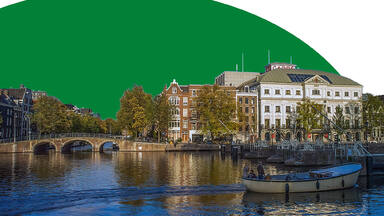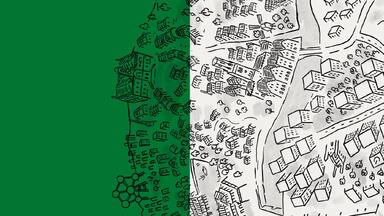Pending feedback: Adapting the approach of the HUL Recommendation for Indonesian universities
The 2021 publication Historic Urban Landscape (HUL) Quick Scan Method. Handbook for Indonesian University Lecturers aims to adapt the HUL Approach to the Indonesian context and promote interdisciplinary learning in universities. The handbook is born out of the cooperation between Indonesian and Dutch partners for the implementation of HUL in Indonesia.
About the 2011 UNESCO Recommendation on the Historic Urban Landscape
On 10 November 2011, UNESCO’s General Conference adopted the Recommendation on the Historic Urban Landscape by acclamation, the first such instrument on the historic environment issued by UNESCO in 35 years.
The Recommendation on the Historic Urban Landscape (HUL Recommendation) calls on Member States to integrate conservation and management of cultural heritage in cities and settlements with policies and practices for sustainable urban development. It applies to all historic cities, not only to historic cities inscribed on the World Heritage List. It advocates a landscape approach for identifying, conserving, and managing historic areas within their broader contexts, considering the interrelationships between the physical forms, natural features, and social and cultural values. The HUL Recommendation is an additional tool to integrate policies and practices of conservation of the built environment into the wider goals of urban development while respecting the inherited values and traditions of different cultural contexts. In order to facilitate implementation, the UNESCO General Conference recommended that Member States take the appropriate steps to:
- adapt this new instrument to their specific contexts;
- disseminate it widely across their national territories;
- facilitate implementation through formulation and adoption of supporting policies; and
- monitor its impact on the conservation and management of historic cities.
Adapting the approach of the HUL Recommendation for Indonesian universities
Following the recommendations outlined in Resolution 41 of the 36th session of the General Conference (36C / Resolution 41), a partnership of Indonesian and Dutch partner cultural institutions has sought to disseminate the concept of Historic Urban Landscape (HUL) in Indonesia. This cooperative effort has resulted in the publication of Historic Urban Landscape (HUL) Quick Scan Method. Handbook for Indonesian University Lecturers. The handbook describes a methodology adapted to the Indonesian context and especially developed to disseminate the HUL approach in universities.
The handbook was published in November 2021 by the Department of Architecture, Faculty of Engineering, Universitas Indonesia, in collaboration with IPB University (Bogor), Universitas Trisakti (Jakarta), Heritage hands-on (Amsterdam), and the Netherlands Agency for Cultural Heritage (RCE), Amersfoort. It seeks to complement and adapt UNESCO’s HUL method (including the 2020 Fukuoka Outcomes and the 2016 HUL Guidebook), exploring opportunities within this framework and promoting the sustainable development of historic cities.
The methodology was initially developed through workshops in Muntok (South Sumatra) in 2018 and Banjarmasin (South Kalimantan) in 2019. Following the lessons learnt in these initial workshops, and based on practical experiences, the methodology was refined and published.
The publication of the handbook aims to promote conversations on the implementation of the HUL Recommendation in Indonesia through participatory workshops organised by Indonesian universities for students and young professionals, together with local stakeholders, communities and governments. This approach is consistent with higher education national policies, such as ‘Merdeka Belajar Kampus Merdeka (MBKM)’, which encourage students to develop interdisciplinary competencies through flexible and self-directed learning. It aims to complement existing heritage courses and promote project-based and collaborative learning, including with the government sector, NGOs, local communities and heritage practitioners.
The Historic Urban Landscape (HUL) Quick Scan Method. Handbook for Indonesian University Lecturers can be downloaded free of charge in English and Indonesian.
Source: Hasti Tarekat Dipowijoyo, Heritage hands-on, 2021
Contribution towards the implementation of the 2011 Recommendation on the Historic Urban Landscape
The project aims to contribute to the implementation of the Historic Urban Landscape approach by developing a methodology adapted to the Indonesian context and promoting its dissemination amongst university lecturers, students and young professionals.
Contribution towards Sustainable Development
If fully implemented in accordance with the described plans, the initiative could contribute towards Sustainable Development and the Sustainable Development Goals.

Goal 4. Ensure inclusive and equitable quality education and promote lifelong learning opportunities for all.
- Target 4.7: the publication aims to provide learners with the knowledge and skills needed to promote sustainable development, including through education for sustainable development and appreciation of culture’s contribution to sustainable development.

Goal 11. Make cities and human settlements inclusive, safe, resilient and sustainable
- Target 11.3: the initiative aims to build capacity for participatory, integrated and sustainable human settlement planning and management by promoting the HUL approach in the Indonesian context.
- Target 11.4: the methodology proposed aims to strengthen efforts to protect and safeguard the world’s cultural and natural heritage by reconciling the goals of urban development with those of heritage conservation in all historic cities.

Goal 17. Strengthen the means of implementation and revitalise the global partnership for sustainable development.
- Target 17.9: the initiative aims to build on international cooperation to implement capacity-building in developing countries to support national plans to implement the sustainable development goals, through North-South and South-South cooperation.
- Target 17.16: the initiative aims to enhance the global partnership for sustainable development, complemented by multi-stakeholder partnerships that mobilise and share knowledge, expertise and financial resources, to support the achievement of the sustainable development goals in developing countries.
Note: the described potential impacts of the projects are only indicative and based on submitted and available information. UNESCO does not endorse the specific initiatives nor ratifies their positive impact.
To learn more
- Browse the Historic Urban Landscape (HUL) Quick Scan Method. Handbook for Indonesian University Lecturers.
- Learn more about the detailed process and results of the workshops of Muntok and Banjarmasin.
Contact
- P.J. (Peter) Timmer MA, Senior Adviser Cultural Heritage
A: Ministry of Education, Culture and Science, Cultural Heritage Agency
www.cultureelerfgoed.nl - Prof. Kemas Ridwan Kurniawan ST. MSc. PhD.,
Head of Architectural Research Unit,
Department of Architecture,
Faculty of Engineering, Universitas Indonesia
www.eng.ui.ac.id
Cover image credits: HUL Quick Scan Method Workshop in Banjarmasin. Author: HUL QS Method Team © Universitas Indonesia
Note: The cases shared in this platform address heritage protection practices in World Heritage sites and beyond. Items being showcased in this website do not entail any type of recognition or inclusion in the World Heritage list or any of its thematic programmes. The practices shared are not assessed in any way by the World Heritage Centre or presented here as model practices nor do they represent complete solutions to heritage management problems. The views expressed by experts and site managers are their own and do not necessarily reflect the views of the World Heritage Centre. The practices and views shared here are included as a way to provide insights and expand the dialogue on heritage conservation with a view to further urban heritage management practice in general.



 4 Quality Education
4 Quality Education
 11 Sustainable Cities and Communities
11 Sustainable Cities and Communities
 17 Partnerships for the Goals
17 Partnerships for the Goals